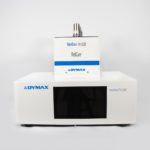Written by Michelle Evanoski, Group Product Manager
Global Business Development, Dymax

Application engineers discuss using a maskant with ISO 10993-5 cytotoxicity approval on an orthopedic implant.
Biocompatibility is a general term to describe that a material’s property is compatible with living tissue or living system. Non-toxic, injurious, or physiologically reactive materials to the body or bodily fluids are considered biocompatible and are often sought by medical device engineers.
In simple words, biocompatibility tests are not used to prove chemical compatibility but to confirm a lack of immune reaction to the material or device.
Choosing the ideal material during the design process gives manufacturers more confidence in an FDA (Food and Drug Administration), MDR (medical device regulation), or other device approval.
Biological reactivity testing is one such process used for determining suitability and safety. Two main tests indicate if the material is biocompatible or not.
USP Class VI biocompatibility testing
Historically, standards were set by the US Pharma Convention (USP), a non-profit organization focused on medications, healthcare technologies, food ingredients, and materials used in medical devices.
These standards categorize materials into six classes depending on the product’s specific use and duration of patient contact time (limited, prolonged, or permanent). Class VI is the most rigorous. It includes three reactivity assessments typically performed in vivo on mice or rabbits to ensure accuracy.
1. Acute systemic toxicity (systematic injection) test: Measures toxicity and irritation when a compound sample is administered orally, applied to the skin, and inhaled.
2. Intracutaneous test: Measures toxicity and localized irritation when the sample is in contact with live subdermal tissue (specifically, the tissue that the medical device intends to contact).
3. Implantation test: Measures toxicity, infection, and irritation of the intramuscular implantation of the compound into a test animal over several days.

A lab tech applies adhesive to a tube set assembly to prepare it for physical property testing.
Although Class VI is typically used to evaluate plastic materials that may be in contact with injectable medications or other fluids, adhesives and sealants that qualify for this designation are generally highly safe for medical devices.
However, materials passing the USP class VI tests are not guaranteed to be biocompatible for every application. It’s simply a strong validation that the materials meet low toxicity requirements usually associated with pharmaceutical tubing, fittings, systems, and parts.
ISO 10993 biocompatibility testing
To standardize the biological evaluation of medical devices globally, the International Standards Organization (ISO) developed ISO 10993 — a set of standards outlining material categories, tests, and test methods used to determine the biocompatibility of materials.
The ISO strategy categorizes medical devices by type of body contact (surface device, external communication device, and implant device) and by contact duration (limited, prolonged, and permanent). The ISO provides a set of suggested evaluation tests for each medical device category.
Typical tests include:
• ISO 10993-4 Hemolysis
• ISO 10993-5 Cytotoxicity
• ISO 10993-6 Implantation 14 Days
• ISO 10993-10 Intracutaneous: Sensitization and Irritation*
• ISO 10993-11 Systemic Toxicity

Medical device adhesives must meet various biocompatibility approvals before being released into the market.
* Note: as of 2021, ISO 10993-10 now contains a description of skin sensitization testing only (Part 10: Tests for Skin Sensitization), and the testing for Irritation is now described in Part 23: Tests for Irritation
In general, adhesives and sealants are not required to pass all ISO tests. However, to be considered of medical grade, it’s expected they pass the cytotoxicity.
As a fast, standardized, sensitive, and inexpensive test, the cytotoxicity test concludes if an adhesive has any adverse effect on mammalian cells. It involves culturing cells in vitro and systematically exposing them to the material in question to see if any reactions or signs of toxicity show up over a few days.
Since the ISO system applies the USP test methods as part of a larger, more rigorous strategy, meeting ISO standards represents a higher level of biocompatibility than meeting USP Class VI standards.









Tell Us What You Think!